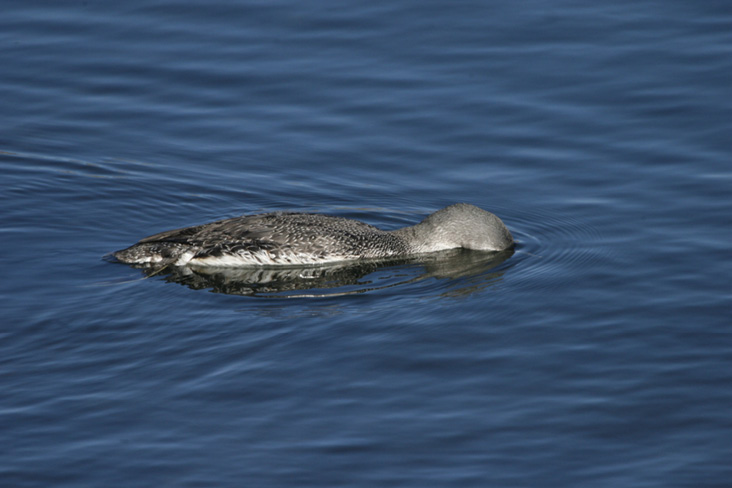Wayne R. Petersen

photo by Wayne R. Petersen
This issue's mystery photo bears a superficial resemblance to a floating log or some similarly-shaped floating debris, or possibly even a defunct military torpedo! However, in spite of my propensity for perversity in past photo quizzes (e.g., biting dipterid flies, upside-down images, or virtually-unidentifiable photos of species such as wood-pewees and crows), the bird in this image is indeed identifiable. And it should go without saying that the mystery bird is a waterbird that swims efficiently, unlike species such as frigatebirds and Sooty Terns or non-waterbirds like the swimming Wild Turkey chicks discussed in the August 2017 "At a Glance."
A subtle clue to the mystery bird's identity is that it is peering down into the water, much like a snorkeling swimmer does when looking at fish beneath the surface—which is exactly what this bird is doing. This observation alone is a clue that the bird includes fish in its diet, because this behavior is seldom observed in other types of diving waterbirds. Fish-eating birds—piscivores—capture fish either by diving from the surface like mergansers or by plunge-diving from the air like terns. This bird is clearly in the surface diving category.
At this point, the mystery bird's identity has been narrowed down to a torpedo-shaped, fish-eating bird that pursues fish by diving from the surface. Reasonable possibilities include loons, tubenoses (i.e., Procellariiformes), cormorants, or alcids. From this list, none of the shearwaters or petrels have the torpedo-shaped body of the mystery diver and none are finely speckled on the back. Both cormorants and alcids—except the Black Guillemot in nonbreeding plumage—are uniformly black above. Keeping these points in mind along with the shape of the bird, the mystery species has to be a loon. But what species?
Once the bird has been classified as a loon, the specific species is straightforward to determine. Only the Red-throated Loon (Gavia stellata) exhibits the finely-spotted back pattern of this bird. In addition, the smooth, light gray coloration of the rounded head and sides of the neck are consistent with this species, as is the hint of white on the face and the sides at the waterline, which indicate that the bird is in nonbreeding plumage. The similarly shaped Pacific Loon would appear much darker on the back and would never exhibit the fine white speckles shown by the pictured loon, although both juvenile Pacific Loons and Common Loons display a barred, not speckled, back pattern in fresh plumage.
Red-throated Loons are common to occasionally abundant coastal migrants in spring from late March to late April, and in fall from mid-October to mid-December. In early November, occasionally hundreds may be seen migrating along the coast in a day, and they regularly occur in winter, especially on Cape Cod. Small numbers also appear on inland lakes in fall, and a few nonbreeders are seen along the coast in summer. The author photographed this adult Red-throated Loon in nonbreeding plumage in Wellfleet Harbor, Massachusetts, on November 28, 2010.
Wayne R. Petersen